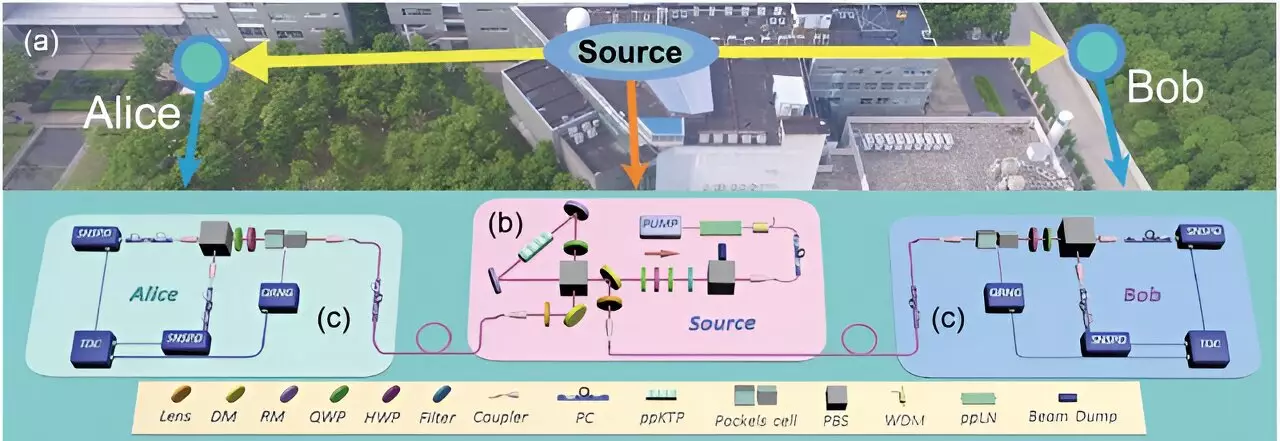Recent advancements in quantum physics have led to a monumental achievement by a research team that reported a loophole-free test of Hardy’s paradox—a concept that has intrigued scientists since its introduction by Lucien Hardy in the 1990s. By investigating the discrepancies between classical perspectives of reality and the quantum realm, this groundbreaking study offers new insights into quantum nonlocality and fortifies our understanding of quantum mechanics.
Local realism posits that physical properties exist independently of observational influence, further asserting that no information can propagate faster than the speed of light. It represents a classical viewpoint that underpins much of traditional physics. However, Hardy’s paradox starkly challenges this notion by indicating scenarios where physical outcomes contradict these foundational principles. The paradox illustrates how certain “Hardy events,” despite their zero probability in classical models, can spawn non-zero probabilities of subsequent events based on quantum predictions, thus revealing a fundamental rift between classical and quantum theories.
Traditionally, prior experimental attempts to validate Hardy’s paradox encountered significant hurdles, primarily due to two prevalent loopholes: the locality loophole and the detection efficiency loophole. The locality loophole arises when the settings for measurements might be influenced by interactions or correlations, thereby skewing outcomes. Meanwhile, the detection efficiency loophole emerges from potential optical losses, which hinder the accurate interpretation of entangled states.
To address these issues, the recent research conducted by a collaborative team spanning the University of Science and Technology of China (USTC) and Nankai University introduced innovative methodologies that significantly enhanced the validity of their experimental framework.
To effectively eliminate the locality loophole, the team designed an experimental setup with precise measurement configurations, ensuring that all measurement choices were separated by spacelike intervals. This meticulous arrangement guaranteed that the entangled states and the measurements were unattached, thwarting any possibility of influence or signaling from one component to another. Such careful spatial distancing reinforced the reliability of their findings, creating a strong foundation to validate Hardy’s paradox.
Addressing the detection efficiency loophole was another challenge that the team met with remarkable success. By achieving an impressive detection efficiency rate of 82.2%, they effectively minimized the effects of optical losses that could cloud results. Additionally, integrating high-speed quantum random number generators allowed for the selection of measurement settings to introduce genuine randomness, further shielding the outcomes from potential local hidden variable manipulations.
The researchers innovatively incorporated undetected events and double-click events into their analysis through a refined version of Hardy’s inequality, which facilitated the closure of the detection efficiency loophole. This refined approach solidified the experiment’s rigor and enhanced its contribution to the burgeoning field of quantum physics.
After an extensive six-hour runtime, the experiment yielded striking results that demonstrated a significant violation of Hardy’s paradox, achieving a statistical significance of up to 5 standard deviations across an astounding 4.32 billion trials. A null hypothesis test revealed that the likelihood of reconciling their findings with local realism was less than 10^(-16348), thus robustly affirming the principles of quantum nonlocality.
These groundbreaking results not only bolster the theoretical underpinnings of quantum mechanics but also pave the way for future technological advancements, particularly in quantum key distribution and quantum random number generation. The implications of such studies ripple through various domains, indicating significant potential for new quantum information technologies.
The research team’s successful loophole-free test of Hardy’s paradox not only represents a milestone in the validation of quantum mechanics but also poses intriguing questions for future inquiries. As scientists continue to unravel the mysteries inherent in the quantum realm, such findings challenge us to rethink core principles of reality and foster further exploration into the wonders of quantum physics. This study stands as a testament to the evolving understanding of our universe, with the promise of groundbreaking innovations on the horizon.


Leave a Reply